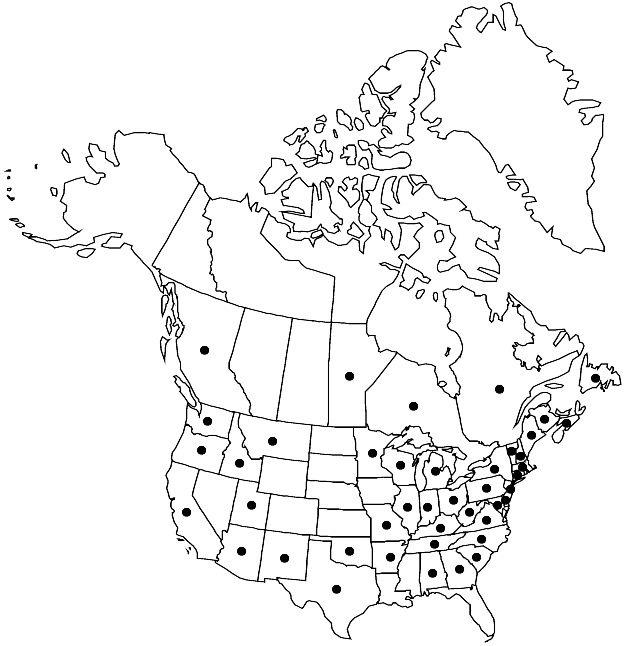Rhynchostegium aquaticum
Ber. Thätigk. St. Gallischen Naturwiss. Ges. 1876 – 77: 378. 1878.
Plants large, in loose tufts or extensive mats, deep green, brownish with age. Stems moderately densely terete-foliate, branches moderately densely terete-foliate; axillary hairs of 4–7 cells. Stem leaves erect or gradually reflexed from erect base, broadly ovate or suborbicular to ovate-lanceolate, 1.5–2.5 × 0.9–1.8 mm; margins serrate; apex ± broadly acute, extreme apices acute to blunt; costa to 70–85% leaf length, terminal abaxial spine inconspicuous, occasionally absent; alar cells somewhat enlarged, to 12–15 µm wide, region indistinct; laminal cells 40–90 × 5–7 µm; basal cells shorter, region in 1–2(–3) rows, indistinctly delimited from adjacent cells. Seta 1–2.3 cm. Capsule 1–2 mm; operculum stout-rostrate. Spores 13–16 µm.
Habitat: Rock, running water of small streams and springs, beds of waterfalls, seepy cliffs, limestone areas
Elevation: low to high elevations (0-2000 m)
Distribution

B.C., Man., N.B., Nfld. and Labr. (Nfld.), N.S., Ont., Que., Ala., Ariz., Ark., Calif., Conn., Del., Ga., Idaho, Ill., Ind., Ky., Maine, Md., Mass., Mich., Minn., Mo., Mont., N.H., N.J., N.Mex., N.Y., N.C., Ohio, Okla., Oreg., Pa., S.C., Tenn., Tex., Utah, Vt., Va., Wash., W.Va., Wis., Mexico, Central America, South America, e Asia, Pacific Islands, Australia.
Discussion
North American aquatic species of Rhynchostegium were long attributed to R. riparioides (Hedwig) Cardot. The molecular phylogenetic analyses by S. Huttunen et al. (2006) and Huttunen and M. S. Ignatov (2010) demonstrated that European-African populations and American-Asian-Australian populations of R. riparioides represent two groups of differing origins. Rhynchostegium aquaticum is widespread in North America. Some species of Hygrohypnum, for example, H. duriusculum, are rather similar, but their double costa distinguishes them. Oxyrrhynchium hians sometimes is similar, but the consistently spinulose abaxial end of the costa in branch leaves is a reliable character of that species, while the costa is smooth or ends in a small, inconspicuous projection in R. aquaticum. Donrichardsia pringlei is also similar, differing in smaller plant size, and stouter costa that reaches 0.85–0.95 leaf length, but is shorter in R. aquaticum. Leaves of R. aquaticum are usually characteristically obtuse, better observed in young leaves. The most reliable difference is the axillary hairs composed of short cells with length to width ratio 1.5–2.5:1 in Donrichardsia, while in Rhynchostegium cells of axillary hairs are long, with length to width ratio 3–6:1 (Huttunen and Ignatov).
Selected References
None.